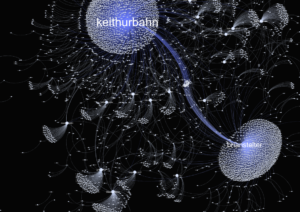Five Rules for Managing Twitter When a Crisis Strikes
Editor’s Note: This is the third article in a week-long series about crisis communications. These guest posts were written by Jane Jordan-Meier, who recently released her book, “The Four Stages of Highly Effective Crisis Management.” You can read all five articles in this series here and purchase her excellent book here.
This rather amoeba-looking graphic, showing how the news of Osama bin Laden’s death was broken and then spread on Twitter, is a graphic reminder of just how the news cycle works today. It’s also a reminder of how powerful Twitter has become to bring us news in a bite-sized, easily consumable 140 characters.
What is most telling in this graph is that that web of human traffic came from one single tweet from Keith Urbahn, Chief of Staff at the office of Donald Rumsfeld (not the country singer). One full hour before the formal announcement of Bin Laden’s death, Urbahn posted his speculation on the topic of the upcoming emergency presidential address. Little did he know that this Tweet would trigger an avalanche of reactions, retweets and conversations that would beat mainstream media as well as the White House announcement.
This is the reality of crisis management in the digital age.
Twitter is the new police scanner. It is a barometer for fascination, education and obsession. But most of all, Tweets are real-time – so in a crisis, raw emotion is as frequent as real news. Twitter information will always be someone’s perception of what they witnessed, what they have seen, what they have experienced. It is the voice of the people.
The Dark Side of Twitter for Companies
We hear and read posts about how Twitter information cannot be trusted, how rogue tweets can dent a reputation or shatter a share price. And yes, that’s all true. A false tweet from one Indonesian student spread like wildfire, caused mass panic and dented the share price of Australia’s flagship airline, Qantas. And then there was the false reporting of Jeff Goldblum’s death, who had apparently died in a tragic climbing accident in New Zealand.
What this all means that organizations MUST respond very quickly indeed to rumors, misinformation, false and/or misleading reports. As soon as Qantas officially reported that no plane had crashed, the share price recovered.
The official information, as important as it is, only adds to the public discourse because we, the inhabitants of Twitterville, decide the truth. We jointly build out and break hypotheses, piecing together all known facts, until what’s believed to be a believable “truth” emerges. There are many of us busy piecing the puzzle together.
Five Rules for Managing Twitter In a Crisis
1. Act Fast: Has always been thus, but now it is a MUST. Organizations MUST, MUST, MUST respond within one hour of the news breaking.
2. Monitor Early and Often: Even a simple Google alert will help. And there is a vast array of social monitoring tools out there.
3. Have a Triangular Approach Ready: If the situation escalates out of Twitter, use three different methods of communicating to your key stakeholders in a crisis – Twitter, your website or blog and at least one key media outlet.
4. Remember We’re Human: We as humans are still incredibly irrational, and constantly make decisions based on our intuition, or whatever we feel like at that moment. We will construct our stories according to our reality.
5. Don’t Just Listen – Hear: Twitter and social media in general are very empowering and powerful motivators when others want to silence us. Iran and Egypt are just two that come to mind. In a crisis, we want someone to hear us, someone to care.
Like it or lump it, Twitter has become a key tool in crisis management. The microblog is a powerful real-time reporting tool for citizen journalists, first responders, and organizations alike. It has become the online circulatory system for news, pumping information between media organs, consumers, and businesses throughout the world.
Twitter, like its social networking cousins, is all-pervasive.
Click here to read all five articles in this special crisis series.
Click here to order Jane’s excellent book.




